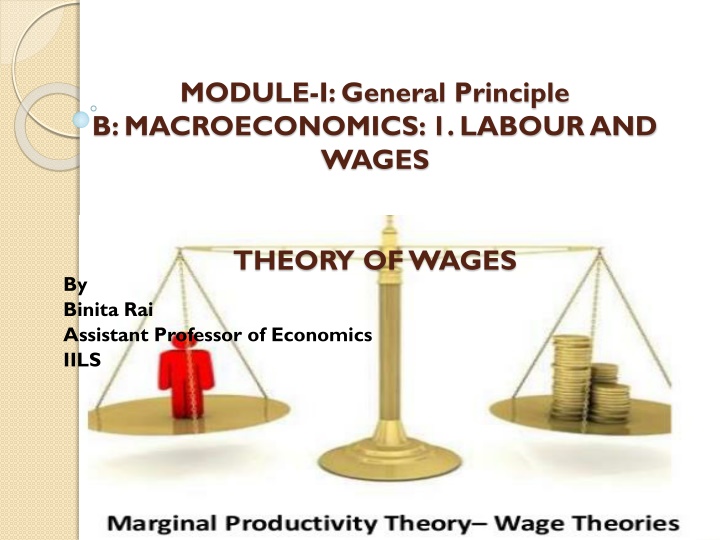
Theories of Wages: Marginal Productivity Theory Explained
Explore the concept of Marginal Productivity Theory of Wages, how it determines worker wages based on productivity levels, and the assumptions underlying this theory. Learn about key theories of wages and dive into a comprehensive discussion on the topic.
Download Presentation

Please find below an Image/Link to download the presentation.
The content on the website is provided AS IS for your information and personal use only. It may not be sold, licensed, or shared on other websites without obtaining consent from the author. If you encounter any issues during the download, it is possible that the publisher has removed the file from their server.
You are allowed to download the files provided on this website for personal or commercial use, subject to the condition that they are used lawfully. All files are the property of their respective owners.
The content on the website is provided AS IS for your information and personal use only. It may not be sold, licensed, or shared on other websites without obtaining consent from the author.
E N D
Presentation Transcript
MODULE-I: General Principle B: MACROECONOMICS: 1. LABOUR AND WAGES THEORY OF WAGES By Binita Rai Assistant Professor of Economics IILS
Some of the most important theories of wages are as follows: 1. Wages Fund Theory 2. Subsistence theory of wages 3. Wage fund theory 4. Standard of living theory of wages 5. Residual claimant theory of wages 6. Bargaining theory of wages
MARGINAL PRODUCTIVITY THEORY OF WAGES Propounded by JB Clark, AC Pigou and Alfred Marshall in the late 1890 s. The marginal productivity theory is a general theory and applied to all the factors of production. The theory explains that under perfect competition a worker s wage is equal to marginal as well as average revenue productivity.
In other words marginal revenue productivity(MRP) and average revenue productivity(ARP) of a worker determine his wages. According to this theory the wages of workers are determined by the marginal productivity. This is also called marginal revenue productivity (MRP).
MRP is the addition made to the total revenue by employing one more unit of a worker. A producer will maximise his profit when the wage of a labourer is equal to the marginal product. In other words, it assumes that wages depend upon the demand for and supply of labour.
ASSUMPTIONS Perfect competition in both product market and factor market The operation of the law of diminishing returns on the application of marginal labour It assumes all workers to be alike and homogenous The theory is based on the assumption of long run It assumes the full employment in the economy It assumes technology to be constant. 1. 2. 3. 4. 5. 6.
Table for ARP & MRP No.of labourers employed Total revenue product(Rs) Average revenue productivity (Rs) 50 60 80 110 120 110 100 90 Marginal revenue productivity (Rs) 50 70 120 200 160 60 40 20 1 2 3 4 5 6 7 8 50 120 240 440 600 660 700 720
RELATION BETWEEN ARP & MRP When ARP and MRP increases the MRP curve lies above the ARP curve. When they fall the MRP curve lies below the ARP curve. When they fall the MRP curve lies below the ARP curve. The MRP curve intersects the ARP curve at the latter s highest point from the above.
fig 1: WAGE RATE DETERMINATION
EXPLANATION In Fig 1 shows number of workers on the X-axis and wages and revenue on the Y- axis. OW is the wage rate at which average revenue and marginal revenue are equal because of the perfect competition. At point E ,ARP and MRP are equal. This is the equilibrium point for a firm. At OW wage rate a firm will employ ON workers.
CRITICISMS It is based on perfect competition which in reality does not exist and has been regarded as unpracticable. It discusses the demand side only ignoring the supply side and this theory is one sided. It is a long run theory and does not apply in the short run. It assumes static state. Production is the result of combined efforts of all four factors of production. It is difficult to measure the share of the labourer in the total marginal productivity.
THANK YOU ANY QUESTIONS????
